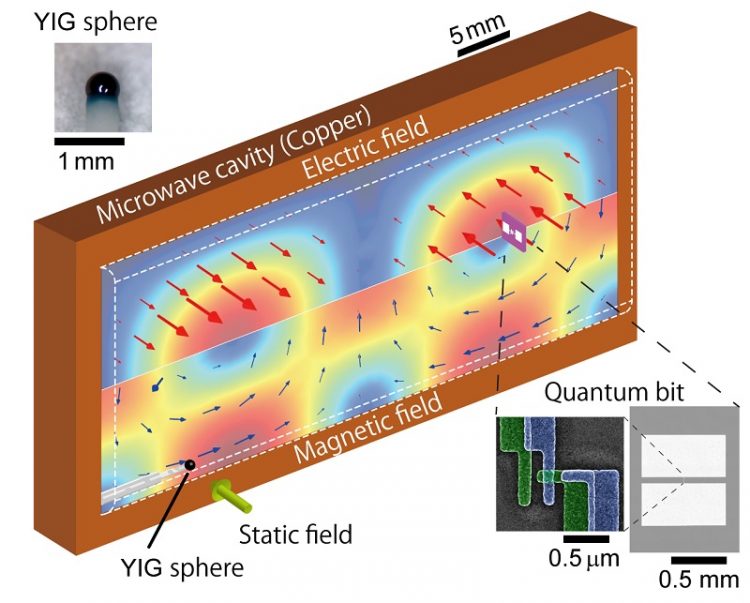Superconducting qubit and magnetic sphere hybrid

Illustration of magnet-qubit coupled system* Copyright : © 2015 Yutaka Tabuchi
Researchers in the University of Tokyo have demonstrated that it is possible to exchange a quantum bit, the minimum unit of information used by quantum computers, between a superconducting quantum-bit circuit and a quantum in a magnet called a magnon. This result is expected to contribute to the development of quantum interfaces and quantum repeaters.
Magnets, often used in our daily life, exert a magnetic force produced by a large number of microscopic magnets – the spins of individual electrons – that are aligned in the same orientation. The collective motions of the ensemble of spins are called spin waves.
A magnon is a quantum of such excitations, similar to a photon as a quantum of light, i.e., the electromagnetic wave. At room temperature the motions of electron spins can be largely affected by heat. The properties of individual magnons have not been studied at low temperatures corresponding to the “quantum limit” where all thermally-induced spin fluctuations vanish.
The research group of Professor Yasunobu Nakamura at the University of Tokyo Research Center for Advanced Science and Technology has succeeded for the first time to couple a magnon in a magnet to a photon in a microwave cavity at an ultralow temperature near absolute zero (-273.14 degrees centigrade). They observed coherent interaction between a magnon and a microwave photon by placing a millimeter-sized ferromagnetic sphere made of yttrium iron garnet in a centimeter-scale microwave cavity.
The research group furthermore demonstrated coherent coupling of a magnon to a superconducting quantum-bit circuit. The latter is known as a well-controllable quantum system and as one of the most promising building blocks for quantum processors. The group placed the magnet together with the superconducting qubit in a cavity and demonstrated exchange of information between the magnon and superconducting qubit mediated by the microwave cavity.
The results will stimulate research on the quantum behavior of magnons in spintronics devices and open a path toward realization of quantum interfaces and quantum repeaters.
*A magnet (ytterium iron garnet; YIG) and a superconducting qubit are placed with a separation of 4 cm. The electric field in the cavity interacts with the qubit, while the magnetic field interacts with the magnet. At an extremely low temperature of around -273 degrees centigrade, magnons, i.e., quanta of the fluctuations in the magnet, coherently couple with the qubit through the electromagnetic field of the cavity.
Associated links
UTokyo Research article
Media Contact
More Information:
http://www.researchsea.comAll latest news from the category: Physics and Astronomy
This area deals with the fundamental laws and building blocks of nature and how they interact, the properties and the behavior of matter, and research into space and time and their structures.
innovations-report provides in-depth reports and articles on subjects such as astrophysics, laser technologies, nuclear, quantum, particle and solid-state physics, nanotechnologies, planetary research and findings (Mars, Venus) and developments related to the Hubble Telescope.
Newest articles

After 25 years, researchers uncover genetic cause of rare neurological disease
Some families call it a trial of faith. Others just call it a curse. The progressive neurological disease known as spinocerebellar ataxia 4 (SCA4) is a rare condition, but its…

Lower dose of mpox vaccine is safe
… and generates six-week antibody response equivalent to standard regimen. Study highlights need for defined markers of mpox immunity to inform public health use. A dose-sparing intradermal mpox vaccination regimen…

Efficient, sustainable and cost-effective hybrid energy storage system for modern power grids
EU project HyFlow: Over three years of research, the consortium of the EU project HyFlow has successfully developed a highly efficient, sustainable, and cost-effective hybrid energy storage system (HESS) that…





















